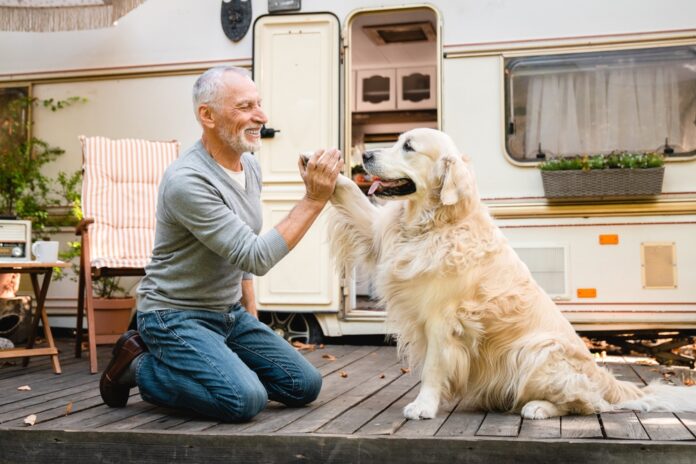Traveling can be one of life’s greatest joys, and sharing those experiences with a beloved pet adds an extra layer of fulfillment. For seniors, embarking on a journey with a furry companion can provide companionship and ease, but it also requires careful planning to ensure both the pet’s and the owner’s comfort and safety.
Preparing for the Journey
Health Check-Up and Medications
Before hitting the road or taking to the skies, it’s crucial to schedule a comprehensive health check-up for your pet. Pets age faster than humans, and regular vet visits can help detect any underlying health issues that might not be immediately apparent. These check-ups may involve blood and urine tests to preemptively spot diseases, as pets often mask symptoms until they become severe. Ensure you have ample supplies of medications and supplements, as prescriptions cannot be transferred between different veterinary clinics. This step is vital in managing any age-related conditions your pet may have.
Understand Travel Regulations
When planning to fly, check with airlines for pet-specific travel requirements, including potential quarantine periods and necessary health certifications. Regulations can vary widely between airlines and destinations, so thorough research is essential.
Comfort and Safety During Travel
Creating a Comfortable Environment
Provide enough space for your pet in the car or plane, allowing them to move freely and helping to alleviate joint discomforts such as arthritis. Using waterproof blankets, pee pads, and accessible water bowls can maintain cleanliness and hydration. Consider temperature variations due to air conditioning or heating, and bring familiar comforts such as their favorite bed or toys to reduce stress.
Stacy Dubuc, a pet owner from Montana, shared her experience of traveling with her senior rescue dog, Ginger. Despite Ginger’s age and health issues, they embarked on a 7,100-mile journey across the U.S., visiting national parks and monuments. Dubuc emphasizes the importance of creating a comfortable environment in the car for senior dogs by bringing familiar items, which can also be used to protect furniture in accommodations.
Legal Requirements
Pets must be legally restrained during travel to prevent injuries in case of accidents. Use harnesses and carriers as appropriate to ensure safety for both your pet and other passengers.
Hydration, Nutrition, and Anxiety Management
Maintain optimal hydration and adjust nutritional intake as activity levels may reduce during travel. Test your pet’s response to travel beforehand and consider calming therapies like Thunder Shirts and pheromones. Always maintain a calm environment within the vehicle to reduce anxiety.
Planning the Route
Research Pet-Friendly Destinations
Research pet-friendly parks and accommodations before your trip. Some areas have restrictions on where dogs can go, so it’s important to verify access ahead of time. Online resources and pet-friendly travel communities can offer guidance.
Websites like BringFido.com and TripsWithPets.com have seen increased bookings, and the hotel industry, including chains like Hilton, has updated policies to accommodate travelers with pets. The trend is fueled by active groups like millennials and seniors who often travel without children. For instance, AARP members planning their trips are offered various travel tips and considerations, including smart tips for dealing with flight issues and dog-friendly vacation ideas.
Emergency Planning
Research and document veterinary clinics and emergency centers along your travel route for any unforeseen health issues. These facilities may have varied operating hours, requiring emergency care if needed. Carry a medical summary and health passport for your pet in case of emergencies.
Pacing the Trip
Balance long driving days with extended stays at a single location, as frequent travel can be stressful for older pets. Adjust plans according to your pet’s comfort, avoiding extreme conditions or strenuous activities. Schedule regular stops for rest, walks, and water to accommodate the needs of older pets that require more frequent breaks due to reduced stamina and bladder control.
Making Memories
Traveling with a senior pet encourages savoring every moment and appreciating the journey at a slower pace. As Kristi Valentini, a travel writer, notes, this approach enriches the travel experience, allowing for deeper connections and unforgettable memories. With thorough preparation and consideration for your pet’s needs, traveling with senior pets can result in memorable experiences.
Products to Consider
- Travel-Sized Water Bowls: Portable and collapsible bowls make it easy to keep your pet hydrated on the go.
- Comfortable Harnesses and Carriers: Ensure your pet’s safety with a well-fitted harness or carrier appropriate for their size and health needs.
- Calming Aids: Products like Thunder Shirts or pheromone diffusers can help reduce anxiety during travel.
- Pet First Aid Kit: Be prepared for minor injuries or health issues with a kit that includes essentials like bandages, antiseptic wipes, and tweezers.
Conclusion
Traveling with a pet as a senior can be a rewarding and fulfilling experience. With careful planning, attention to your pet’s health and comfort, and a spirit of adventure, you can create lasting memories together. Always prioritize safety and be prepared to adjust your plans to accommodate your pet’s needs. Happy travels!


